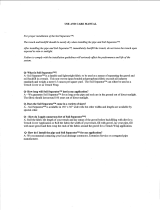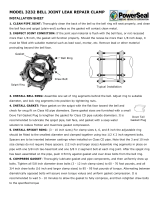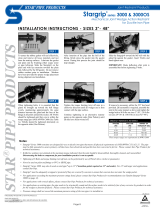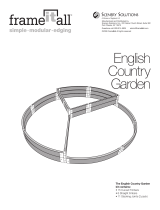Page is loading ...

SECTION 2
AMERICAN
Pipe Joints

2-10
The AMERICAN Fastite Joint is a push-
on type joint meeting all the rigorous
requirements of AWWA C111. The
ANSI/AWWA C600 Standard covers in
detail the installation of ductile iron water
mains, including assembly instructions for
push-on joint pipe.
Field-cutting of AMERICAN Ductile Iron
Pipe can be easily performed, thus eliminat-
ing the necessity for factory-made special
lengths of Fastite pipe. The plain end of
Fastite pipe cut in the field requires little or
no preparation for assembly into the socket
of a mechanical joint fitting. Where a cut
pipe is to be assembled into a Fastite socket,
the required beveling or rounding of the
plain end can be easily accomplished by the
use of a portable grinding wheel or other
suitable apparatus. Methods of cutting duc-
tile iron pipe are described in Section 3.
The AMERICAN Fastite Joint requires
only one joint component, the rubber gas-
ket*, which when properly installed, fits snug-
ly in the gasket recess in the bell socket. A
special lubricant supplied with the pipe is
applied to the plain end and the inside surface
of the gasket before assembly. The pipe end
is tapered or rounded to provide self-centering
of the plain end in the gasket and ease of
assembly. A circumferential stripe on the plain
end provides a visual indication for checking
the proper insertion of the joint. The stripe,
shown in the photographs illustrating assem-
bly methods, passes fully into the bell when
the plain end is fully inserted into the socket
with the two lengths of pipe in straight
alignment. Joints can then be safely deflected
up to the extent shown in Table No. 2-3. In
deflected joints, the stripe will typically be visi-
ble to some extent after assembly.
Easier assembly is effected if the pipe is
suspended an inch or so off the bottom of
the trench during the jointing operation.
The following instructions should be fol-
lowed in order to properly assemble the joints
and to fully realize the maximum speed and
ease of assembly of the Fastite Joint:
1. Clean socket and plain end thoroughly,
removing mud, gravel, or any other matter
that might cause the front of the gasket to
protrude into the path of the entering spigot.
2. Insert gasket fully into the gasket recess
of the socket, large end of the gasket entering
first. Gasket may be installed with one or two
V-shaped folds as shown (Photo 1). After the
gasket is in place at the bottom, the top of the
gasket is positioned fully into the gasket recess.
Gaskets and lubricant to be installed in very
cold weather should be warmed first (as by
storage in a heated equipment cab or pick-up,
etc.) for optimum assembly.
3. Apply a thin film of regular AMERI-
CAN Fastite Joint Lubricant to the rounded or
tapered spigot end of the pipe, the immedi-
ate outside pipe surface between the stripe
and the nose of the pipe (Photo 2), and also
to the inside surface of the gasket. Special
AMERICAN Fastite Joint Lubricant intended
specifically for underwater or very wet instal-
lations can be supplied when requested.
AMERICAN Fastite
®
Joint Pipe
Assembly Instructions
Photo 1 Photo 2
*Gaskets not used immediately should be stored in a cool location, out of direct sunlight.

2-11
Caution: If a spigot end contacts the
ground or trench side after lubrication, any
adhering dirt or rocks should be cleaned off
and the area re-lubricated prior to assembly.
4. Insert the plain end in the socket. For
optimum assembly it is preferable that the
entering pipe be in reasonably straight align-
ment; however, the Fastite Joint may be
assembled if necessary with the pipe deflect-
ed within its rated deflection. (Exception: If
Fast-Grip gaskets are being used, straight
alignment must
be maintained.) Push the
plain end into the socket using any of the
applicable assembly methods described
hereinafter. If the joint cannot be assembled
with a moderate force, remove the pipe and
check for the cause of the difficulty, such as
improper positioning of gasket, insufficient
or wrong type lubricant, dirt under or behind
the gasket, dirt adhering to the pipe, or any
other cause which would result in obstruc-
tion or increased friction between pipe end
and gasket surface. For assurance of proper
assembly, a thin automotive, blade-type
feeler gauge can also be used if desired for
quick and easy probe confirmation of cor-
rectly installed axial gasket position around
the joint.
5. “Backwards” installation. AMERICAN
does not recommend “backward laying”
(bells assembled over spigots, rather than
spigots inserted into bells as pictured in this
literature) of large-diameter ductile iron pipe
in buried installations. AMERICAN can furnish
bell and plain end fittings to minimize the
need for backward pipe laying. Other
devices such as sleeves and couplings may
also be employed for this reason. However,
if this condition cannot be avoided, we
strongly recommend that installers contact
AMERICAN for instructions on how to reduce
the potential for problems that could occur
when assembling pipe in this manner.
In general, Fastite joints or other Fastite
gasketed pipes may be readily pushed or
pulled together without the need for com-
plicated tools or substantial manpower. This
is most often accomplished with the proce-
dures discussed on page 2-14. In general,
the joints of AMERICAN push-on pipes are
purposefully “tight,” and most joints require
an assembly force of about 100 to 200
pounds or more of assembly force per inch
of pipe diameter (i.e. a 12" joint might
require about 12 x 100 or 1,200 pounds of
assembly force).
In pulling operations, simply wrap a
sound wire rope choker cable or nylon sling
around the barrel of the entering pipe.
Secure the thimble eye or other end loop of
the choker to a suitably anchored pulling
device (e.g. backhoe, come-along, etc.).
Use the mechanism to pull the cable taut in
the assembly direction (Photo 3). Continue
pulling the cable in a smooth, continuous
motion until the joint is in the fully assembled
position. If desired for special conditions,
AMERICAN can furnish suitable, simple
come-alongs and choker cables for man-
Photo 3
AMERICAN Pipe Assembly Mechanisms

2-12
power assembly of most 4"-24" pipes (See
Figure 1 and specify pipe sizes involved).
The joints may normally be disassem-
bled in a similar manner, reversing the
direction of the pull with the choker cable
(Photo 4). It is also sometimes helpful to
use rebating or wiggling deflection to aid in
the disassembly of push-on joint pipes, par-
ticularly when pipes have been installed for
some time prior to removal.
30"-64" Pipe
Large pipes are most often readily
pushed or pulled together with heavy exca-
vating/earthmoving equipment available on-
site (see page 2-14). In cases where assembly
of pipes by manpower is desired, AMERICAN
can provide special assembly tools and rigging
which can be used for assembling most pipes
of all sizes (Photo 5). These tools consist of a
heavy-duty roller chain hoist, a steel pipe-end
hook and snatch block, and associated wire
rope and chain tackle (Photo 5) to attach all
the rigging together to effect “double line”
assembly from the top of the pipe (Photo 6).
The snatch block pulley and twin line rigging
approximately doubles the assembly force
from the strong come-
along, making possi-
ble the assembly of up
to 64" full-length pipe
joints from the top of
the pipe (Photo 7).
Fittings and Short
Pipes
Push-on fitting or
short pipe joint assembly is basically the same
as that of standard length pipe, though special
rigging may be necessary to hold these short
items reasonably stable for assembly. See also
Push-On Fittings Assembly Instructions in
Section 4.
Field Rounding
Occasionally, field rounding of pipe ends
may be necessary to accomplish assembly,
particularly when large-diameter pipes are cut
to be assembled into mechanical joints or
couplings. Need for rounding in assembly of
mechanical or stuffing-box-type joints can be
predetermined by a difficulty in sliding the
gland or end ring over the end of the pipe.
Rounding may be accomplished in the fol-
lowing manner using a mechanical jack and
shaped blocks. (Note: This procedure may
also be used with the assemblies involving
push-on joint pipe, fittings, valves, etc.; how-
ever, rounding is less frequently necessary for
assembly of push-on joints.)
Photo 5
Photo 6
Photo 7
Photo 4
Figure 1

2-13
AMERICAN Fastite
®
Joint Lubricant
Requirement by Size of Pipe
Table No. 2-5
14 .03 33
16 .045 22
18 .06 17
10 .07 14
12 .08 12
14 .09 11
16 .11 19
18 .12 18
20 .14 17
24 .17 16
30 .30 13
36 .36 13
42 .44 12
48 .50 12
54 .59 12
60 .66 11
64 .71 11
Pipe Size
in.
Approx. Pounds
of Lubricant
per Joint
Approx. No. of
Joints per Pound
of Lubricant
64" AMERICAN Fastite Joint pipe being
installed in a wastewater application.
Note: Field rounding operations should be
conducted without backfill on any part of
large-diameter pipes and prior to encasing
any part of pipe in concrete. If the inside of
the pipe cannot be accessed to remove jack-
ing materials, pipe ends can alternatively be
rounded using external clamping means.
1. Measure/determine the minimum
(minor) diameter of the ends to be rounded.
2. Place the jack and the shaped blocks
in line with the minor diameter as shown in
the attached sketch using a sound 4"x4"
spacer timber cut square to the required
length to take up the space.
3. Apply a load carefully with the jack
only
until the “minimum diameter equals the
maximum diameter,” or until the gland will
easily slip over the end. No more jacking should
be attempted or necessary - DO NOT ATTEMPT
TO PERMANENTLY ROUND END.
4. After the joint is completely assem-
bled and the bolts (if involved) are uniformly
tightened to the required torque, carefully
relax and remove the jack and timbers from
the pipe.
SHAPED BLOCK
SHAPED BLOCK
4"x4" timber cut to
desired length. Use any
suitable timber available
from dunnage on car,
truck or other source.

2-14
Spade or Crowbar Method
This is applicable to the smaller sizes
of AMERICAN Fastite Joint Pipe, and con-
sists of centering the lubricated end of the
entering pipe in the gasket and then
pushing against the bell face of the enter-
ing pipe with a spade or crowbar driven
into the ground in front of the bell face.
This method requires the trench bottom
to be fairly firm soil. The method may not
be effective in a rocky trench or with a
trench that is soft, muddy or sandy. A
wooden block between the bell face and
the pry bar may increase the leverage.
Easier assembly is effected if the pipe is
suspended an inch or so off the bottom of
the trench.
Backhoe and Heavy Equipment
Methods
These methods are usually applicable
to the intermediate and larger sizes of
AMERICAN Fastite Joint Pipe where the
bar method might not be effective. It
consists of centering the end of the enter-
ing pipe in the gasket as the pipe to be
assembled is suspended from the back-
hoe. Then it can be pulled into the adjoin-
ing socket with the pipe sling by moving
the backhoe arm toward the previously
assembled pipe. In other instances, the
pipe may be assembled by placing the
backhoe or other earth mover bucket or
blade against the bell face of the entering
pipe and pushing it into the socket. When
pushing against the bell face, care should
be taken to avoid very small contact areas
and possible damage to the pipe bells or
spigots. Wood cushions between the
backhoe bucket and the pipe are particu-
larly effective in preventing damage.
AMERICAN Fastite
®
Joint
Common Assembly Methods
In seeking ways to take even greater advantage of the cost-reducing features of
the Fastite Joint, utility contractors have developed other methods of assembling this
joint without special tools. The following methods are described for the information of
the user, who may elect to use them at his discretion, keeping in mind that these meth-
ods may not be effective for all installations and under all field conditions.
Spade or Crowbar Method
Backhoe and Heavy Equipment Methods
/







